How to hang a hood over a gas stove: step-by-step installation guide
The hood is an integral attribute of any, even the smallest kitchen. Without it, it’s difficult to talk about comfort - the rich aromas of 3-5 dishes at the same time mix into an unpleasant amber and fill the airspace. How to deal with this negative phenomenon?
To eliminate the negative mixture of aromas will help exhaust equipment. We will tell you how to hang the hood over a gas stove and what tools you need for this. Based on our tips, you can competently equip the kitchen space.
The content of the article:
Important rules for installing the hood
Hoods are needed in kitchens with both electric and gas stoves. And instilled their installation in the second case are slightly different. Indeed, when using a gas stove, cooking occurs under the influence of open flame. This feature must be taken into account before installation.
In the process of cooking on a gas stove, not only the aromas of condiments fill the air - the smell of burning gas is distinctly felt in the kitchen. It is he who introduces confusion into the question of the correct choice of the optimal distance for future hoods.
Therefore, before purchasing exhaust equipment for the kitchen should calculate its powerso that you don’t have to change the equipment almost immediately after installation.
So, sometimes you can hear the erroneous recommendations of some craftsmen to hang this device lower at a distance of 50-60 cm from the level of the plate. According to them, this will allow better and faster to remove carbon monoxide from the room.
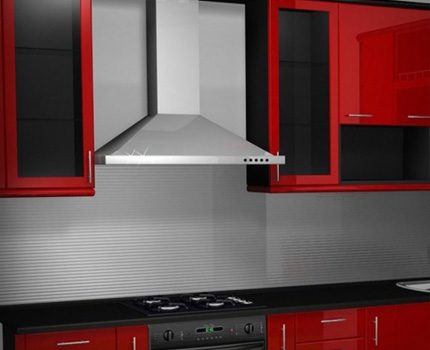
Such advisers forget that open fire can easily be thrown onto the body of the exhaust equipment and then troubles can not be avoided. Especially dangerous can be the situation when the grease filters have already become contaminated - they can ignite in a matter of seconds.
To prevent this from happening, you need to remember at what height hang a hood above a gas stove. The permissible range is between 75-85 cm. Moreover, as experienced craftsmen advise, in some cases a 5 cm error is possible if the hood does not fit differently.
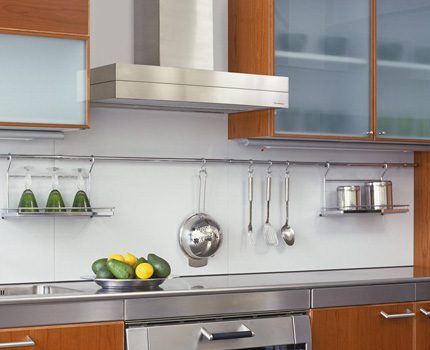
In addition to the distance from the stove to the hood, there are other important installation rules, including:
- proper installation of equipment;
- safe connection to the electric network;
- proper connection to the ventilation system.
To exhaust equipment for many years to work properly, helping to get rid of the symbiosis of various flavors in a timely manner, it remains to be established, strictly adhering to the basic rules of installation. You can do it yourself or invite a master from a company with a good reputation.
Another important rule that affects the quality of installation and the future indoor climate is compliance with the recommendations of the equipment manufacturer. First of all, you should carefully read the tips on the installation height of the purchased hood model, given by the company that made it.
Then you need to study the recommendations of the manufacturer of the gas stove in the appropriate section. The instructions should pay particular attention to tips on the height of the exhaust device.
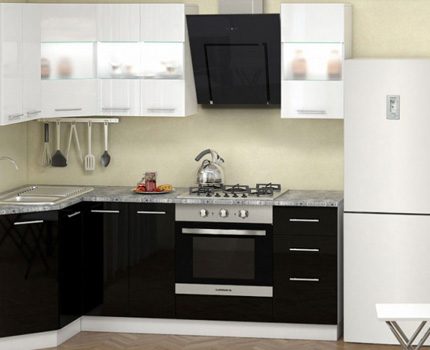
Often you may find that the recommendations for one and the second device are significantly different. Manufacturers of hoods can indicate the installation height of their equipment at 40-50 cm from the stove. In this case, you need to focus only on the distance indicated in the instructions for the stove.
If the accompanying documentation for the gas stove is lost, then the hood above it can be hung at a distance of no lower than 75 cm.
Step-by-step installation of the hood over the gas stove
With the installation and connection of the hood it is quite possible to cope on their own. A simple set of tools is useful for this: a drill or a screwdriver, a hacksaw for metal, a screwdriver, a pencil, a level, a tape measure. You will also need a general idea about the installation of exhaust equipment in domestic conditions.
Preparing for installation work
To install the hood start after the equipment itself has already been purchased. First of all, you need to read the instructions for the hood and the gas stove, paying particular attention to the height of the upcoming installation.
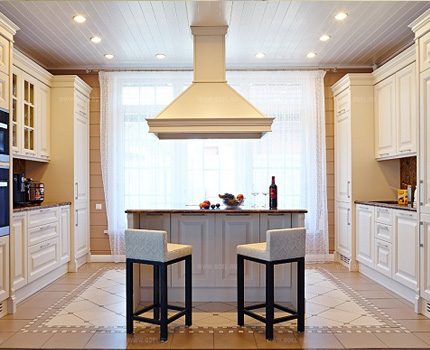
After studying the recommendations, you can start marking the place of the future deployment of the exhaust device over the gas stove. It all depends on its type, model and principle of operation.
There are inclined, angular and island hoods and embedded models. The place where the markup is to be made depends on which model will stand in a particular kitchen. In any case, it is advisable to proceed with its installation only after installing and connecting the gas stove.
You need to mark the place for installing the hood strictly above the gas stove, measuring the distance upwards within 75-85 cm. Then you have to plan the location of the ventilation pipe, which will be mounted to the hood. For coal models, this is irrelevant.
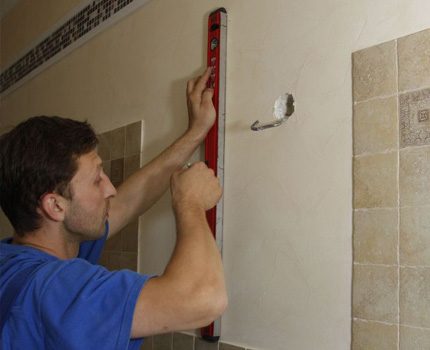
Mounting the hood over the gas stove
When the marking is over, you can proceed with the installation of the hood. Here the order of work depends on the model of equipment - for the built-in hood you have to work a little with a hinged cabinet in which it will be hidden.
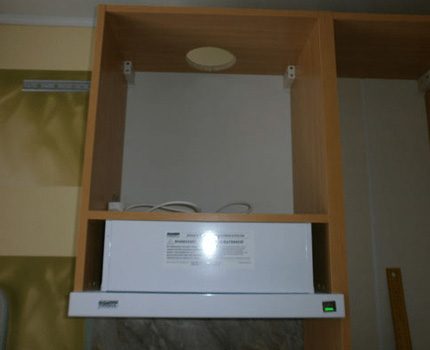
In the section of the wall cabinet, the lower shelf will have to be raised to a height corresponding to the height of the hood itself. This is about 15-25 cm. Then, directly to this shelf, it is necessary to attach the hood with screws using the holes already existing in the housing.
If there are no holes, then you can do them yourself, carefully measuring the place of future fastening. If the model is dome, corner or island type, then it will be enough to hang it on mounts pre-installed in the wall or ceiling.
It is important when mounting the hood body not to lift it by the decorative parts, so as not to accidentally break it. If you have any doubts about your abilities, then to install an expensive model it is better to immediately invite a specialist.
Connecting the hood to the ventilation system
If the hood has already taken its place above the gas stove, you can proceed to the next step - connecting it to the ventilation system. Although in some situations you can do without it - everything will depend on the principle of operation of the installed equipment.
According to the principle of action, the following types of hoods are distinguished:
- with air vent;
- purification of exhaust air in recirculation mode;
- 2 in 1 - operation of the equipment is possible both in the exhaust mode and in the air recirculation mode.
In the first type of devices, a grease filter is installed, designed to remove particles of fat before removing the exhaust air from the premises. Also, there is always an air duct through which the air masses move from the room.
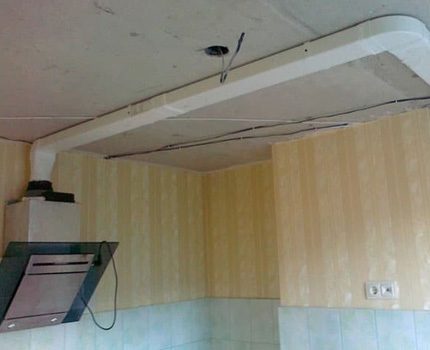
In the second type of hoods, grease and charcoal filters are used - the former remove fat and the latter filter the air masses, eliminating soot, burning, particles of water and other impurities that give an unpleasant odor.
The third type of equipment also has 2 types of filters and is equipped with an air duct, which is not in coal hoods. Such a structure ensures functioning in the air removal mode and in its purification mode without removal.

Therefore, it is important to understand the hood with which operating principle will now be installed. After all, the coal model does not need to install the duct.
For other types of hoods, it is necessary to connect to a common ventilation system. To do this, you need a corrugation or plastic duct, adapters, clamps, sealant and metallized tape.
After connections to the ventilation duct You can put a decorative casing on the duct. Many hood type hoods are equipped with a beautiful cover designed to mask the ventilation pipe going into the ventilation.
Electrical connection
When the main installation work has been completed, it remains to connect the hood located above the gas stove to the mains. Regardless of the type and principle of operation, all hoods require power supply. Without this, the exhaust fan simply won’t start.
To connect to the network there can be 2 options:
- plug in;
- connecting directly.
The first option is the easiest and most convenient. If there is a free outlet, and the hood already has a wire with a plug at the end, then it will be convenient to hide it in the cable channel, extending to the outlet.
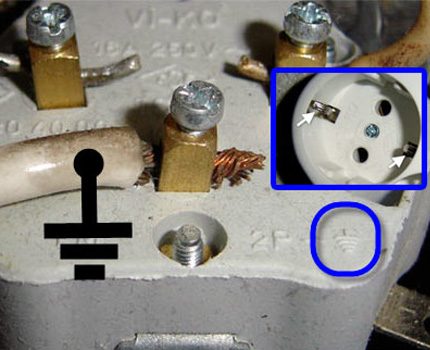
But acting on the first option is not always possible - often there is simply not enough free outlet for the hood. Some models have too short a wire with a plug that does not reach the desired outlet. Therefore, you have to connect directly.
It is important to correctly connect all the exhaust wires to the power cable so that the earth connects to the ground, phase and zero to the corresponding wires. Wiring should be carried out strictly when the power is off, and hands should be protected with special gloves.
After such a connection, the contacts must be isolated. It is also imperative to check whether current is flowing to the hood body.
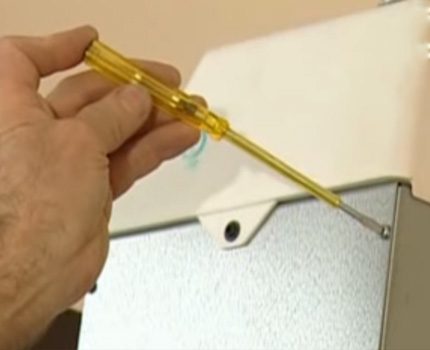
After the connection is completed, it remains to turn on the power and check the operation of the exhaust equipment. Everything is simple here - just turn on any drawing speed and attach a sheet of paper.
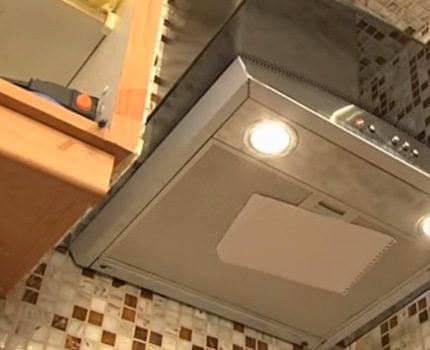
The main mistakes when installing the hood
Even experienced home craftsmen who repeatedly perform various repairs in their apartment / house can make mistakes when installing a hood over a gas stove. And the newcomers to this business are even more so.

The most common mistake is the incorrect height for mounting the device. So, often the person responsible for the installation considers it unnecessary to spend his time reading the instructions and simply relies on the opinion of a neighbor / comrade, authoritative in his eyes, who claims that 60-70 cm is enough.
Especially often this situation can be found in kitchens where no one cooks. Indeed, in order to brew coffee and heat pizza, an extract hood is not needed. Therefore, the hood in this kitchen for the time being will play a decorative role. As soon as a hostess appears there, inspiredly sculpting culinary delights, there is a purchase of a new one or reinstallation of a low-hanging hood.
The second error during installation is the insufficient width of the equipment. It should be remembered that for normal operation, the width of the hood should be the same as that of the stove.
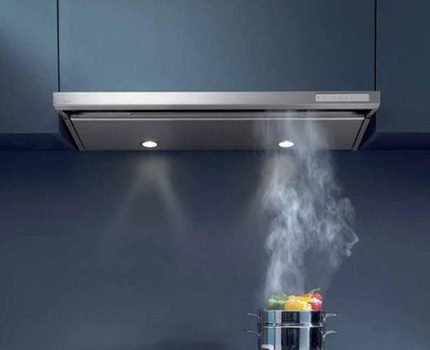
The third mistake relates more to design - it will not affect the functioning of the equipment. This is about exhaust hoods with air ductsconnecting the device with the ventilation shaft - in areas of open space, it is desirable to mount a plastic one. This will visually give a more sophisticated appearance to communications.
For air ducts that hide under a decorative cover, corrugation can be used in a plasterboard box or in a suspended ceiling. Also, this option is acceptable for models of hoods that are mounted in a hanging cabinet. The duct will hide perfectly in the same cabinet - you just have to cut through the corresponding hole under it.
About how it is made connection of a cooker hood without duct written in detail in our proposed article.
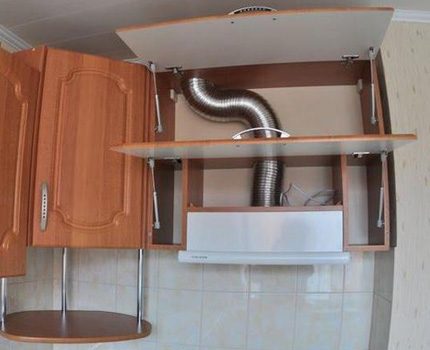
Another mistake is made by beginners when working with a hood with decorative glass. When installing it over a gas stove, you have to be extremely careful not to accidentally damage the decorative case. In no case should you lift equipment holding onto the glass.
The fifth mistake is an incorrect connection to the power supply. This situation is not fraught with the most pleasant consequences if the current goes through the hood. Basically, this problem occurs with the direct connection of the device wires with a power cable by a home novice master.
If the hood will be plugged in, it is important that the electric point is removed from the gas stove by a distance of 60 cm. Compliance with the rules and safety standards will protect against accidental ignition of the wiring.

All errors can be avoided by taking a responsible attitude to each stage of installation work. The correct installation and connection of the hood over the gas stove with each step brings an excellent result. Qualitatively installed equipment will please any housewife and will last much longer than its operational life.
Conclusions and useful video on the topic
To integrate the hood with the air duct into the furniture cabinet, you need to drill a hole for the ventilation duct.More details about the intricacies of this work in the video clip:
The hood hood can be hung on screws screwed into the wall. About this in the next video:
Video clip about how high the hood should be mounted in a kitchen with a gas stove:
So that the hood in the kitchen was not only functional, but also looked aesthetically pleasing, it should be installed and connected correctly. The main secrets are revealed in the video:
A detailed video clip about mounting and connecting an inclined hood:
Installation of the hood over the gas stove can well be done independently. It is important to maintain the minimum permissible height from the plate, so that in the future there will be no problems during its operation. Even a novice will be able to collect the hood and connect it.
If the installation work is terrifying, then you should not save - it is easier to invite a master with a good reputation and entrust him with the installation.
Want to talk about how you installed the hood in your kitchen? There were questions in the process of familiarization with the information provided, is there any useful information on the topic of the article? Please comment on the material in the block below, ask questions, leave a photo.

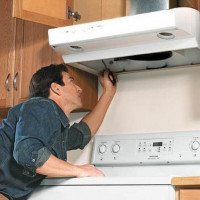 How to install a hood above a gas stove: step-by-step installation instructions
How to install a hood above a gas stove: step-by-step installation instructions 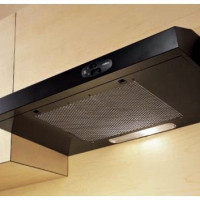 Installing the built-in hood: location options and installation instructions
Installing the built-in hood: location options and installation instructions 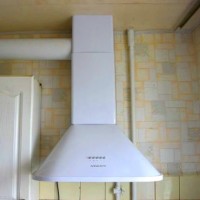 How to install the hood if the gas pipe interferes: briefing on the work
How to install the hood if the gas pipe interferes: briefing on the work 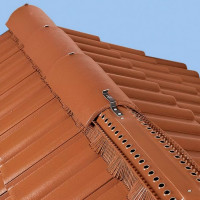 Ventilation of the roof ridge: types + installation manual for ridge strips and aerators
Ventilation of the roof ridge: types + installation manual for ridge strips and aerators 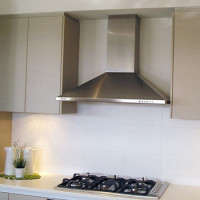 Hood for a kitchen with an air duct: how to arrange a hood in the kitchen with and without a duct
Hood for a kitchen with an air duct: how to arrange a hood in the kitchen with and without a duct  How to connect a kitchen hood to ventilation: a work guide
How to connect a kitchen hood to ventilation: a work guide  How much does it cost to connect gas to a private house: the price of organizing gas supply
How much does it cost to connect gas to a private house: the price of organizing gas supply  The best washing machines with dryer: model rating and customer tips
The best washing machines with dryer: model rating and customer tips  What is the color temperature of light and the nuances of choosing the temperature of the lamps to suit your needs
What is the color temperature of light and the nuances of choosing the temperature of the lamps to suit your needs  Replacement of a geyser in an apartment: replacement paperwork + basic norms and requirements
Replacement of a geyser in an apartment: replacement paperwork + basic norms and requirements
A low hood installed is also inconvenient when used. I installed it in the winter, and in the summer I had to redo it. The large vat with blanks for the winter could not be delivered because of the height, and it itself already worked poorly from excessive oil deposits on the details. What should definitely not be done during installation is to connect it directly to the current. It is not always possible to repair it on the spot. With this I came across in my experience. It is better to bring a socket under the hood.
It seemed to me that everything is primitive, in fact. Hanging the hood is simple, you can handle it yourself. I hung, just did not take into account the factor of convenience, my wife constantly beat her head about her, hung too low. I thought that the lower, the better and more odors will be captured, but it turned out to be completely different. I had to raise it higher. So, this also needs to be considered during installation.
Installing the hood and duct is not difficult, but there is a moment on which no one focuses - the installation of the casing. How to install it, if there is a bar above the hood and the standard casing does not go there?
In this case, you need to abandon the use of a standard casing. Either you pick up the retractor without a hood so as not to overpay the money, or if the extractor hood is already purchased, then there are several options. The first is to adjust the standard casing to the current parameters, for example, make a cutout or gap under the bar, which interferes with installation. The second is to make a casing yourself or order it, taking into account the current individual parameters.
Or you can refuse the casing and close the corrugation with a false panel, for example, of such a plan. It seems to me that this is the best option, in the form of a cabinet with a door.